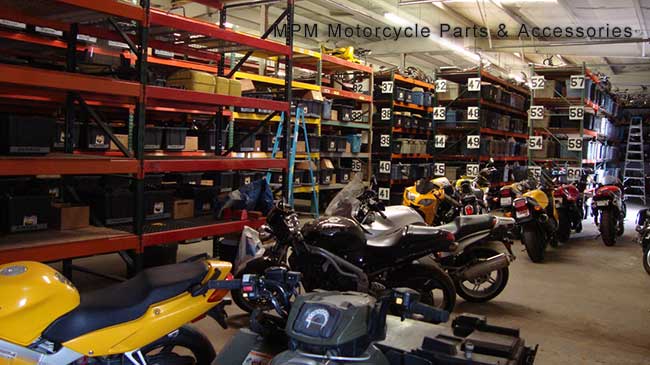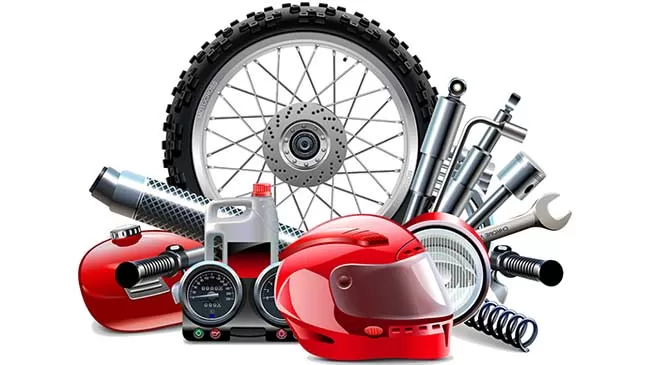Motorcycle aftermarket parts are components or accessories that are not manufactured by the motorcycle original equipment manufacturer (OEM). These parts are manufactured by third-party manufacturers and are designed to fit and function on a specific motorcycle model. Aftermarket parts can include a variety of items such as sprockets, chains, brake rotors, filters, wheels, exhaust systems, handlebars, seats, fairings, and performance upgrades like suspension kits or engine modifications.
When it comes to replacing or repairing motorcycle parts, motorcycle owners have the option of taking their vehicle to a dealer’s auto shop or an independent shop. If you take your motorcycle to a dealer for service, you will get OEM parts. If you take your bike to an independent shop, you’ll likely be able to get aftermarket motorcycle parts. what is the difference? Below we’ll discuss OEM parts vs. aftermarket parts and discuss the pros and cons of each.

Motorcycle OEM (Original Equipment Manufacturer) parts are components or accessories that are produced by the original manufacturer of the motorcycle. These parts are designed to meet the specific standards and specifications of the motorcycle brand and model. OEM parts are often considered to be the most reliable and high-quality option for replacing or repairing components on a motorcycle.
OEM parts are manufactured by the same company that produced the motorcycle, ensuring that they are designed to fit perfectly and function as intended. They are made to the exact specifications and quality standards required by the motorcycle manufacturer, and they are often the same parts that were originally installed on the motorcycle during its production.
OEM parts are designed and manufactured by the original motorcycle manufacturer, ensuring that they meet the highest quality and performance standards. They are built to the exact specifications and are rigorously tested to ensure reliability and durability.
OEM parts are designed to fit seamlessly with specific motorcycle models. This ensures that they integrate perfectly with the existing components and systems of the motorcycle, minimizing the risk of compatibility issues.
OEM parts typically come with a warranty from the motorcycle manufacturer. This warranty provides assurance that the parts are backed by the manufacturer, offering protection against defects and ensuring peace of mind for the motorcycle owner.
OEM parts maintain the consistency of the motorcycle’s original design and performance. They are engineered to work harmoniously with other components, preserving the intended performance, handling, and safety features of the motorcycle.
OEM parts are accompanied by detailed documentation and support from the manufacturer. This can include technical specifications, installation instructions, and access to customer support for any questions or issues related to the parts.
When using OEM parts for repairs or maintenance, the originality and quality of the motorcycle are preserved, potentially enhancing the resale value of the bike.
OEM parts are often more expensive than aftermarket alternatives. The higher cost can be a deterrent for motorcycle owners, especially when compared to aftermarket parts that may offer similar functionality at a lower price.
OEM parts may not offer the same level of customization and variety as aftermarket parts. Motorcycle enthusiasts seeking specific performance enhancements or aesthetic modifications may find aftermarket options more appealing due to their wider range of choices.
Depending on the specific part and the age of the motorcycle, OEM parts may be more challenging to obtain, especially for older or less common models. This can lead to longer lead times and potential delays in repairs or maintenance.
Some motorcycle manufacturers may restrict the availability of OEM parts, requiring customers to purchase them exclusively from authorized dealerships or specific outlets. This limitation can potentially reduce the convenience and accessibility of OEM parts.
Aftermarket parts are often at the forefront of innovation and performance enhancements. Motorcycle enthusiasts seeking to push the boundaries of performance and customization may find aftermarket parts to be more aligned with their specific goals.
OEM parts generally have fixed pricing, leaving little room for negotiation or price adjustments. In contrast, aftermarket parts may offer more flexibility in terms of pricing and discounts.

Aftermarket parts are components or accessories for motorcycles that are produced by companies other than the original equipment manufacturer (OEM). These parts are designed to replace or enhance the original factory-installed components and are often available from a wide range of manufacturers and suppliers.
Aftermarket parts provide a wide range of customization options, allowing motorcycle owners to personalize their bikes according to their preferences. This can include different finishes, colors, materials, and styles to create a unique look and feel.
Many aftermarket parts are designed to improve the performance and handling of motorcycles. Upgrades to the engine, exhaust system, suspension, brakes, and other components can enhance power, responsiveness, and overall riding experience.
Aftermarket parts can often offer cost savings compared to OEM components. This makes them an attractive option for motorcycle owners seeking specific upgrades or replacements without breaking the bank.
Aftermarket parts are generally more widely available than OEM parts, especially for older or less common motorcycle models. They can be purchased from a variety of retailers, online stores, and specialty shops, providing greater accessibility and convenience.
Aftermarket parts are often at the forefront of innovation, offering new technologies, materials, and designs that may not be available from the original manufacturer. This allows motorcycle owners to access the latest advancements in the industry.
Aftermarket parts can offer greater flexibility in terms of compatibility with different motorcycle models. They may be designed to fit a range of makes and models, providing versatility for motorcycle enthusiasts.
Aftermarket parts cater to the specific needs of motorcycle enthusiasts who are looking to fine-tune their bikes for racing, off-road riding, touring, or other specialized purposes. This includes components designed for specific performance characteristics and applications.
The quality of aftermarket parts can vary widely depending on the manufacturer and supplier. Some aftermarket components may not meet the same quality standards as OEM parts, leading to potential issues with fitment, durability, and performance.
Not all aftermarket parts are guaranteed to be compatible with specific motorcycle models. Fitment issues can arise, requiring modifications or adjustments to ensure proper installation and functionality.
Installing aftermarket parts may void the original manufacturer’s warranty, particularly if the aftermarket components cause or contribute to mechanical issues. This can lead to potential challenges in obtaining warranty coverage for other parts of the motorcycle.
Some aftermarket parts may require more complex installation procedures compared to OEM components. This can lead to higher labor costs if professional installation is necessary, or it may require additional time and effort for DIY installation.
Customizing a motorcycle with aftermarket parts may impact its resale value, as some buyers may prefer stock or OEM-equipped bikes. The personalization choices made with aftermarket components may not align with the preferences of potential buyers.
Certain motorcycle manufacturers may restrict the availability of OEM parts, requiring customers to purchase exclusively from authorized dealerships or specific outlets. This limitation can reduce the convenience and accessibility of aftermarket parts.
While some aftermarket parts are designed to enhance performance, others may not meet the same standards of reliability, longevity, and safety as OEM components. Choosing reputable manufacturers and suppliers is crucial to minimize these concerns.
In some regions, aftermarket parts may not comply with local regulations or emissions standards, potentially leading to legal or operational issues.

OEM parts are guaranteed to fit and almost always come with a manufacturer-backed warranty. They may cost more than aftermarket offerings, but the trade-off is that the buying process may be simpler. If you’re looking for a fast, simple experience and don’t mind paying the extra cost, OEM is usually your best option.
Join our mailing list to be the first one to know more new parts release and marketing info. Stay informed!


We will contact you within 1 working day, please pay attention to the email “wholesale@mpm-motorsports.com”
Comments